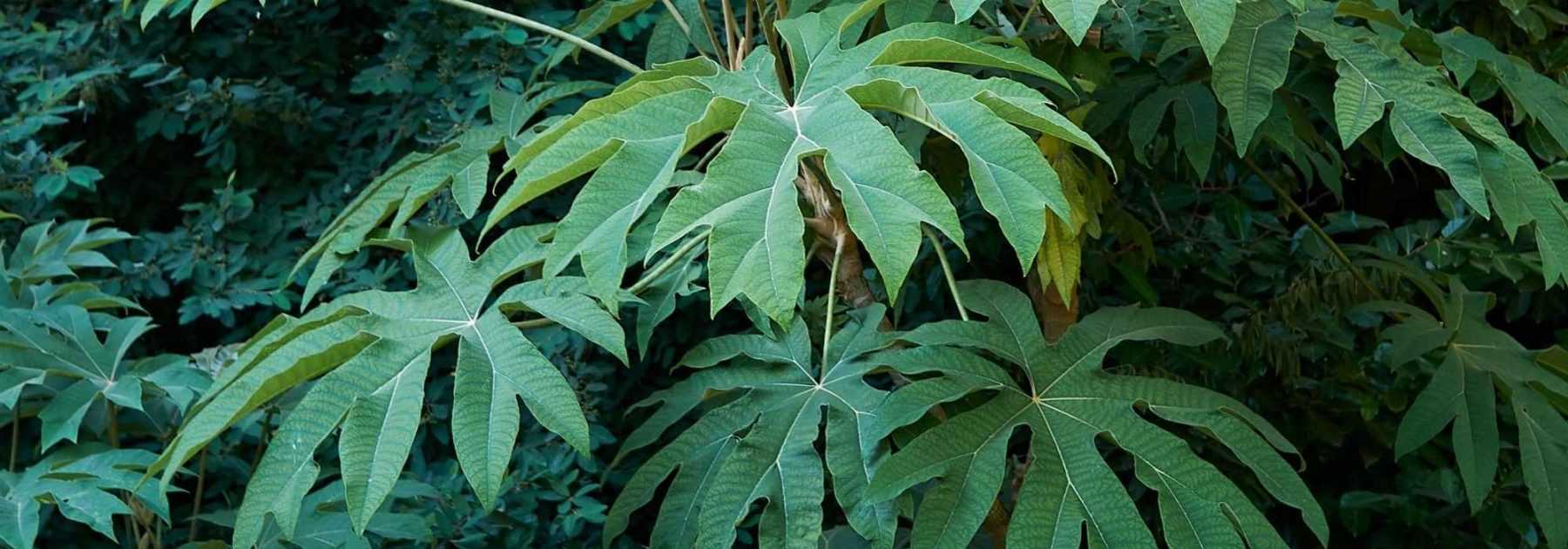
Tetrapanax, Rice Paper Plant: Planting, Growing, Care
Contents
The Tetrapanax in a few words
- The Tetrapanax, or Rice Paper bush, is a bush with a decidedly lush and exotic appearance
- Its palmate, deeply cut leaves can reach gigantic proportions
- With rapid growth, easy cultivation and disease-free nature, it typically reaches 4m in height
- Evergreen in mild climates, it’s hardy down to approximately -12°C
- This shade-loving bush thrives in rich, moist yet well-drained soil
- It’s particularly favoured in urban jungle designs, Japanese or contemporary gardens
Our expert's word
The Tetrapanax papyrifera is a bush that brings a decidedly exotic touch to any landscape design. With rapid growth, it is easy to cultivate, has no known pests and requires minimal maintenance. At maturity, and depending on growing conditions, it can reach between 4 and 6 m, producing leaves of impressive dimensions. Palmate and deeply lobed, particularly in cultivars like ‘Rex’, they are green and pubescent, more rarely variegated, as with the variety ‘Variegata’. Nicknamed the Rice Paper Plant, its powerful roots can spread, the young plant producing suckers, sometimes forming small thickets worthy of a tropical jungle. With moderate hardiness, its foliage becomes deciduous below -5°C, but the plant can endure short frosts of around -10°C, or even slightly harsher. Thriving in warm, humid environments, it grows ideally in partial shade, in rich, loose, fertile soil that remains cool in summer without retaining water in winter. Highly prized in Japanese-style gardens, it enhances the lushness of exotic settings, and its striking appearance also makes it a favourite in contemporary gardens. While capable of vigorous growth in open ground, it can also be grown in a large pot to adorn a sheltered balcony, terrace or patio, as wind may damage its foliage. Under optimal conditions, it may flower in late summer, with panicles of small cream-white flowers, though their ornamental appeal is not universally admired.
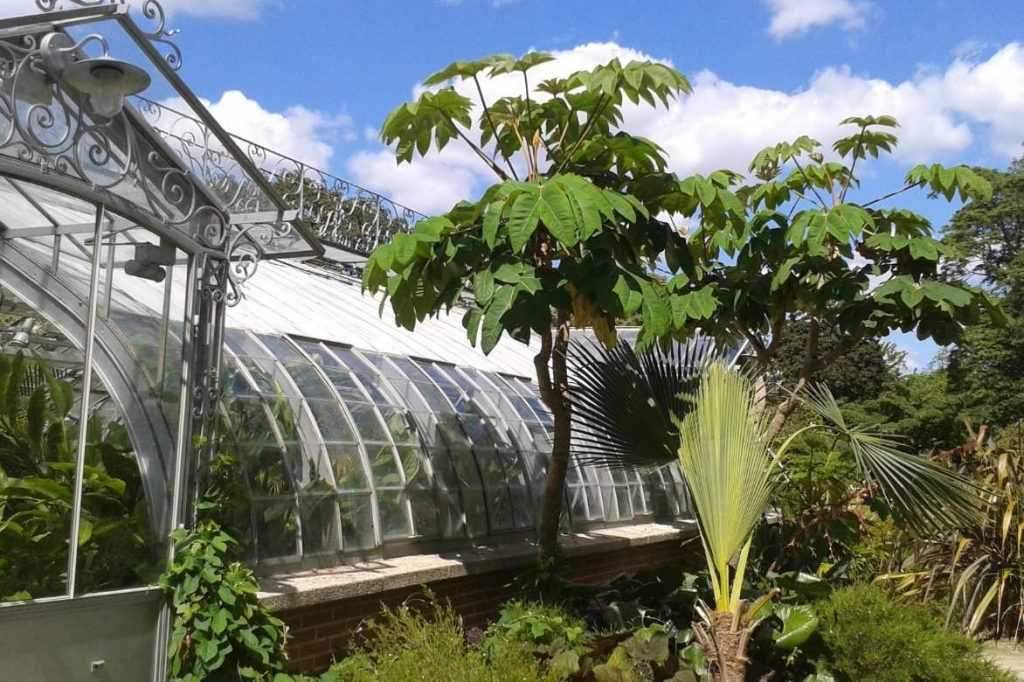
Tetrapanax at the Jardin des Plantes in Nantes (©Gwenaëlle David)
Description and botany
Botanical data
- Latin name Tetrapanax papyrifera
- Family Araliaceae
- Common name Rice-paper plant
- Flowering Summer to autumn
- Height 1.5 m to 6 m
- Exposure partial shade, non-scorching sun
- Soil type any fresh, well-drained soil
- Hardiness moderate (-10 to -15°C)
The Tetrapanax papyrifera is a bush or small tree from the Araliaceae family, like the Aralia, Ivy or Schefflera. Its botanical name has evolved, and several references have been associated with it, including Aralia mairei, Aralia papyrifera, Didymopanax papyriferus, Echinopanax papyriferus or Fatsia papyrifera.
Native to southern China, Taiwan and the Japanese Ryukyu Islands, the Tetrapanax grows naturally on mixed forest hillsides, between 100 and 2800 m altitude, as well as in subtropical forests.
Its genus name comes from the Greek ‘tetra‘, referring to its flowers’ stamens, numbering four, and the Latin ‘panax‘ (itself derived from the Greek ‘panakeia‘), meaning ‘all-healing’. Panax is also the genus name of Ginseng, with which it shares some resemblance.
There is only one species, T. papyrifera (or T. papyrifer), the name papyrifera referring to its pith, used in Asia to produce the famous rice paper in which food is sometimes wrapped, a characteristic that earned it its common name of Rice-paper plant. This pith is also said to have medicinal properties, being febrifuge (reducing fever), diuretic, sedative and anthelmintic.
Capable of growing up to 6 m tall (or more) in its native habitat, this bush with an exotic look generally reaches between 1.5m and 4 m in our latitudes, depending on growing conditions. Its spread can also reach 2 to 4 metres. With rapid growth, the Tetrapanax is primarily cultivated for its extremely decorative, exotic-looking palmate foliage. The bush develops a sparsely branched trunk topped by petioles 50 cm to over 1m long bearing enormous leaves. These, arranged in a fan shape, are compound and can be up to 1 m wide. Divided into numerous lobes (5 to 11), they give the plant its particularly graphic appearance. Bright green and shiny on top, their underside is felted. Young shoots, light brown to silvery, are pubescent. The fine hairs on the leaves may, in some sensitive individuals and with prolonged contact, cause respiratory system irritation.
Between late summer and autumn, and if the climate is favourable, the bush produces long panicles of small globose pom-poms, made up of tiny melliferous flowers, with 4 petals and 4 stamens, cream white. Hermaphrodite, the plant then produces small round fruits, purple-black at ripeness, called drupes.
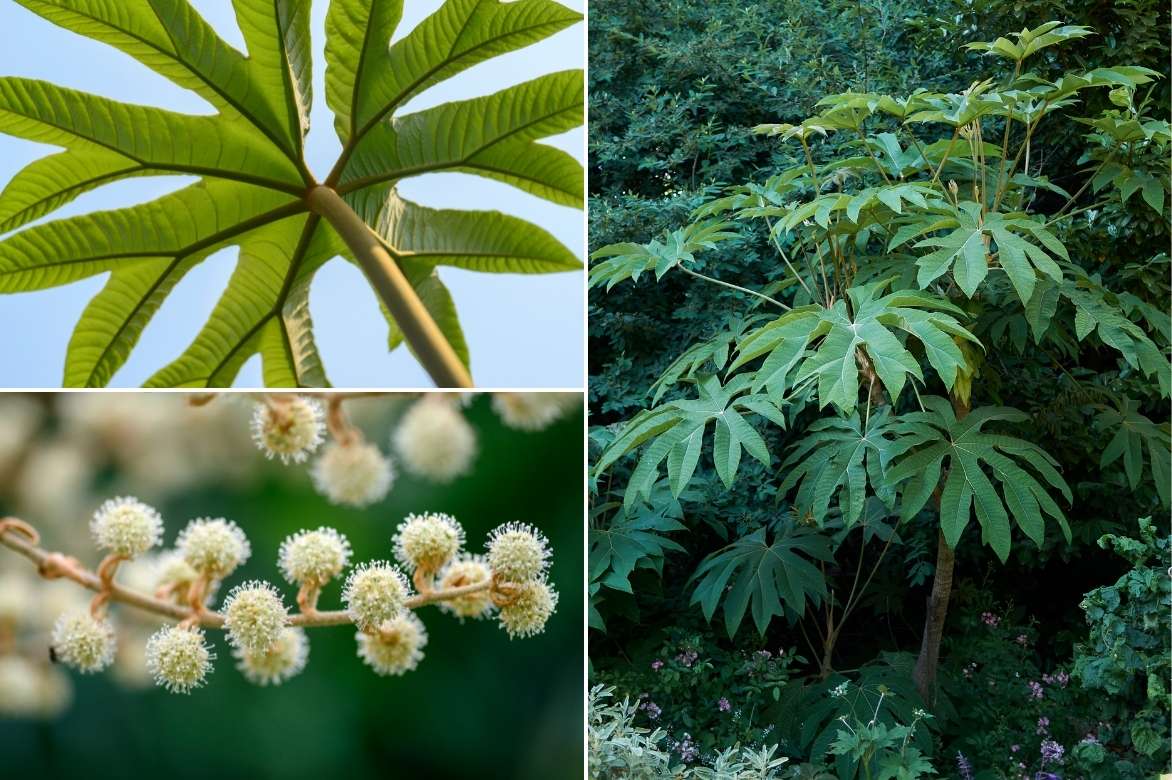
Foliage, flowering and habit of Tetrapanax
While the genus comprises only one species, several horticultural varieties have emerged. Thus, Tetrapanax papyrifera ‘Variegata’ has variegated foliage in different shades of greens and cream. Tetrapanax ‘Rex’ like ‘Steroidal Giant’ (very similar) display strongly veined and deeply divided foliage, reminiscent of the sharp claws of the dinosaur of the same name, the T-Rex. ‘Empress’ is slightly more bushy and spreads a little less than the type.
Exuberant, the Rice-paper plant develops indeed on roots that readily produce suckers, sometimes quite far from the main stump, especially if they are damaged. “New” specimens are then produced. Left in place, they can form thickets, but it’s also an opportunity to take these suckers to propagate the plant. In some regions of the world (Hawaii, Australia, New Caledonia, Réunion), under a warm and humid climate, the Tetrapanax spreads to the point of being considered invasive. This behaviour is less pronounced under our metropolitan climate, and installing a root barrier allows in any case to control it. If you don’t want new plants to appear, pull up young suckers as soon as they emerge.
The Tetrapanax enjoys both warm and humid atmospheres. Depending on the region, place it in sun or partial shade, while avoiding exposure to scorching rays, which can burn its foliage. Windy exposures are not suitable either, as its leaves may tear, especially if they rub against other woody plants. The ideal remains a sheltered semi-shaded exposure, benefiting from some sun in early morning or late afternoon.
Moderately hardy, its leaves are destroyed by frost from -5°C, but the stump resists minimum temperatures around -10°C to -15°C, and it can then regrow from the stump. The variety ‘Rex’ (or ‘Steroidal Giant’) offers better hardiness than the type. In mild climates, the Tetrapanax remains evergreen and keeps its foliage all winter. Under these conditions, its trunk thickens and can reach 10 cm in diameter, while continuing to grow taller.
Any type of rich, deep soil, fresh in season but properly drained in winter suits it.
Tolerant of sea spray, it can suit coastal gardens with high humidity. It also finds its place in Asian-inspired gardens, to create exotic and lush atmospheres, and its bold graphic quality makes it a bush for modern and contemporary landscaping. Growing it in a large pot poses no problem, allowing it to be installed on a terrace or balcony, where its original look never goes unnoticed.
Very easy to grow, the Tetrapanax is unaffected by diseases and requires almost no maintenance. It is therefore an easy-going bush, to be planted and admired.
Different species
[product sku=”822312″ blog_description=”The most popular! Its huge, lobed and downy foliage is green. Exuberant, it brings a tropical touch to the garden, reminiscent of prehistoric vegetation. It spreads through its roots and can be quite vigorous, but what a look!” template=”listing1″ /]
Discover other Tetrapanax
View all →Available in 3 sizes
Planting
Where to plant?
The Tetrapanax papyrifera thrives ideally in deep, rich and fertile soil. Good summer humidity and fresh soil allow it to develop impressively large leaves. However, ensure water does not stagnate at its base in winter, at the risk of reducing its hardiness or causing its roots to rot.
Although it enjoys warm environments, avoid placing it in full sun, particularly under the scorching midday rays. Partial shade suits it perfectly, but it will also tolerate growing in darker areas of the garden.
Sensitive to wind, provide it with a sheltered spot.
You can plant it directly in the ground in a patio or garden, alongside bushes and perennials, as a standalone feature, or even in a pot on a terrace or balcony.
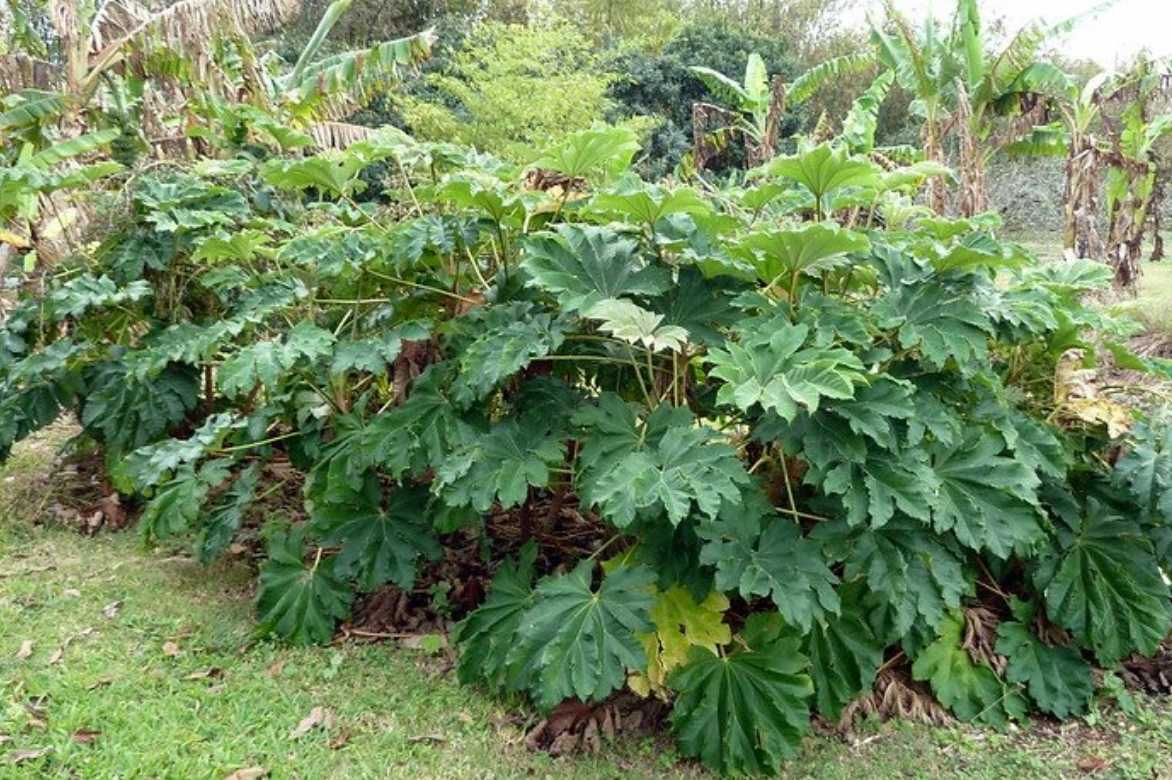
Tetrapanax (© Wendy Cutler)
When to plant?
The Tetrapanax can be planted in autumn in regions with mild climates. Elsewhere, spring is preferable.
How to plant?
Planting in the ground
- Soak the root ball in a large volume of water to thoroughly moisten the substrate.
- Meanwhile, dig a hole about 3 times the size of the pot, and loosen the soil well.
- Mix compost into your soil, and add coarse sand if it is heavy. The mixture should be aerated and supple. Incorporate one or two spadefuls of compost depending on the hole size, two handfuls of slow-release fertiliser (such as crushed horn) and mix everything together.
- Remove your plant from its pot and position it in the centre.
- Fill in with your mixture and lightly firm around the base.
- Water generously.
- Mulch to a thickness of about 5 cm, extending widely around the base. Preferably use an organic mulch (ramial chipped wood, dead leaves, buckwheat or cocoa husks, pale flax…)
Ensure the soil remains moist during the season, and don’t hesitate to water regularly for the first two years if rainfall is low.
Pot planting
- Choose a pot larger than the original container.
- Ensure there is a drainage hole in the bottom of the pot, then add a drainage layer about ten centimetres deep (clay pebbles, gravel…)
- Soak your plant in a large volume of water to saturate the substrate.
- Prepare a rich, well-draining mixture, consisting for example of good compost (2/3) and coarse sand (1/3). Add one or two handfuls of compost and a handful of slow-release fertiliser, such as crushed horn.
- Pour your mixture into the pot, leaving space to position your young plant in the centre.
- Fill in with the remaining mixture, lightly firm and water abundantly.
- Mulch with your chosen material, organic or mineral depending on your layout style.
Care and maintenance
The Tetrapanax is a low-maintenance plant.
In the ground
- Simply ensure moisture at the base during the season, and water during periods of intense heat or insufficient rainfall.
- Check the mulch regularly, and top up if necessary.
- Remove damaged or dried leaves when they become unsightly.
- You can fertilise your bush with a nitrogen-rich fertiliser twice a year (early spring and early autumn).
- In case of severe winter cold, you can protect the trunk by wrapping it in horticultural fleece, optionally padded with straw.
In a pot
- Repot your Tetrapanax into a larger container at least every two years during its early growth. For example, if initially planted in a 10-15 litre pot, move it to a 35-45 litre pot the following year to allow its running root system space to expand. The larger the pot, the more vigorous your young plant will be.
- Potted soil dries out faster, so it’s essential to prevent complete dehydration. Daily watering may be necessary in summer, preferably in the evening.
- To improve air humidity, fill a saucer with clay pebbles and water, then place the pot on top. If the air is very dry, daily misting of the foliage is beneficial.
- In winter, position your pot in a sunny spot if possible. You can also wrap the trunk in horticultural fleece for added frost protection, or move the pot to a frost-free, well-ventilated, and bright location.
- In early spring, refresh the top layer of soil. This involves replacing the top few centimetres with fresh, nutrient-rich substrate. Take the opportunity to add compost or organic fertiliser.
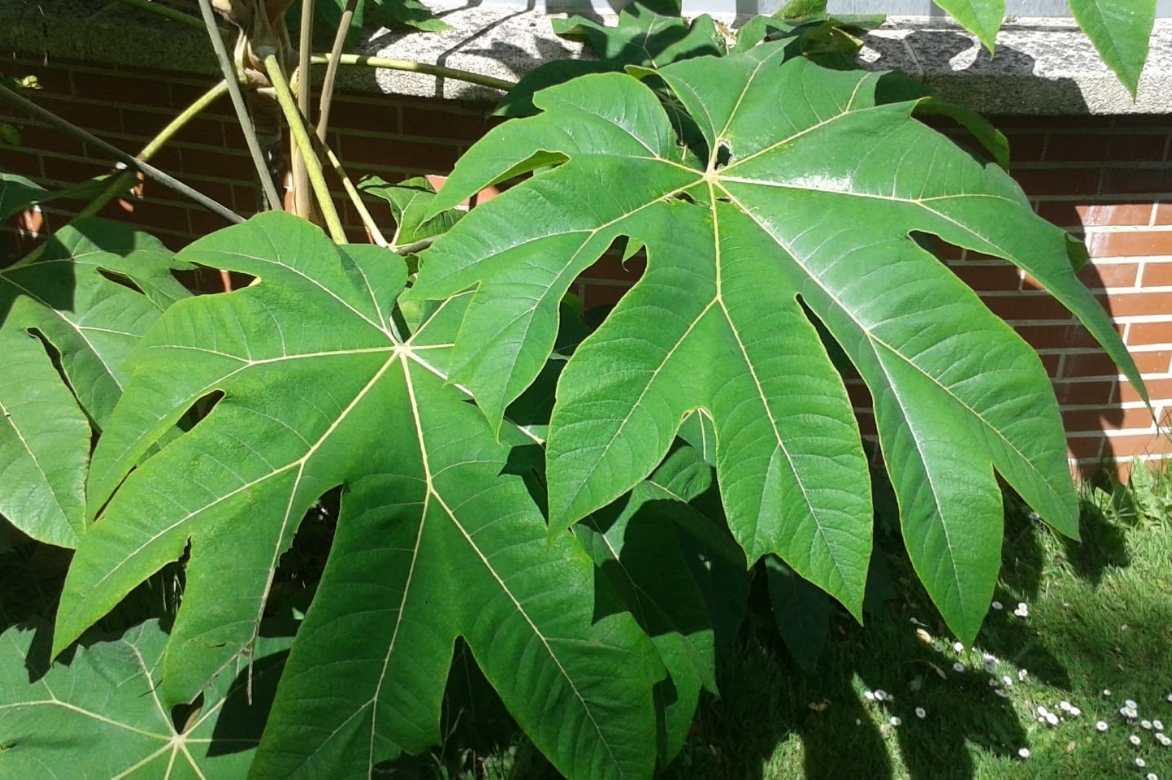
The impressive foliage of the rice paper plant (© Gwenaëlle David)
Propagation
The Tetrapanax can be propagated by removing suckers, propagation by cuttings of roots or sowing.
Removing suckers
The Tetrapanax has a running root system and regularly produces suckers around the main plant. The simplest method is therefore to remove these suckers. Carry out this process when the plant is in its growth period (spring, summer).
- Using a sharp spade, remove a sucker, taking care to keep as many roots as possible.
- Remove all the lower leaves, keeping only one or two at the top.
- Plant immediately in a pot large enough for the root system to develop.
- Water and store in partial shade.
- Keep the substrate moist, and ensure the young plant is not exposed to intense cold during winter.
- Replant in the garden the following spring.
Propagation by cuttings of roots
Propagation by cuttings of roots is another effective method. Carry this out in early spring or autumn.
- Collect roots with a diameter roughly equivalent to that of a thick pen, and cut them into sections about 7 cm long. To identify the correct orientation when planting, cut the upper part (closest to the parent plant) horizontally and the lower part (towards the root tips) at an angle.
- Prepare a very light potting mix, such as special sowing and cuttings compost, or mix standard compost with sand or, even better, perlite or vermiculite.
- In a large pot, insert the root sections a few centimetres apart, pushing them vertically into the substrate until two-thirds buried. Ensure the cuttings are inserted the right way up (angled part downwards).
- Water and cover with a thin layer of small gravel.
- Place the cuttings in a bright, warm location.
- Keep moist until the first leaves appear.
- Once new leaves have developed well, repot the cuttings into individual pots and monitor watering.
- Plant in their final position the following spring.
Sowing
You can also try propagating your bush by sowing.
The seeds are ready to be sown towards the end of autumn or early winter, once they have reached ripeness. As their seed viability is quite short, do not wait too long to use them.
- Sow the seeds in individual pots, at a depth equal to their diameter. Use a light compost, such as ‘Special Sowing’ mix.
- Water lightly and keep warm.
- Keep the substrate moist to the touch.
- When the young plants produce their first true leaves, repot them into individual buckets.
- Replant in their final position the following spring, once the risk of frost has passed.
Pairing Tetrapanax in the Garden
The Tetrapanax is a bush cherished by enthusiasts of lush, tropical-looking gardens. Its large, deeply lobed leaves can quickly transform a garden into a miniature jungle from the far corners of the world.
- In this setting, it pairs wonderfully with the Japanese Aralia, whose equally decorative foliage bursts into fiery hues come autumn. With leaves resembling those of the Tetrapanax but with a more compact habit and slower growth, the Fatsia enhances the tropical woodland atmosphere. The cream-splashed green leaves of varieties like ‘Spider’s Web’ shine particularly bright in shaded areas. Naturally, hardy palms such as the Chinese Windmill Palm or broad-leaved banana trees fit perfectly alongside the Rice Paper Plant. You could also contrast its oversized foliage with the equally exuberant leaves of a Gunnera. To play with leaf shapes, complement with Rodgersias, Colocasias, or ferns, including the sculptural Dicksonia antarctica. Add a splash of colour with Begonia grandis, whose stems, flowers, and leaves take on pink to purple hues.
- Its origins make the Tetrapanax ideal for Japanese-inspired gardens, where it thrives alongside bamboos, rhododendrons, and azaleas. Essential additions include the Japanese Maples, renowned for their stunning autumn colours. Nandina, Pieris, and Camellias complete the ensemble beautifully, as do the late-flowering Japanese Anemones. Finally, low-growing perennials like the luxuriant-leaved Hosta or the graceful, swaying Hakonechloas form tapetums that frame their neighbours exquisitely.
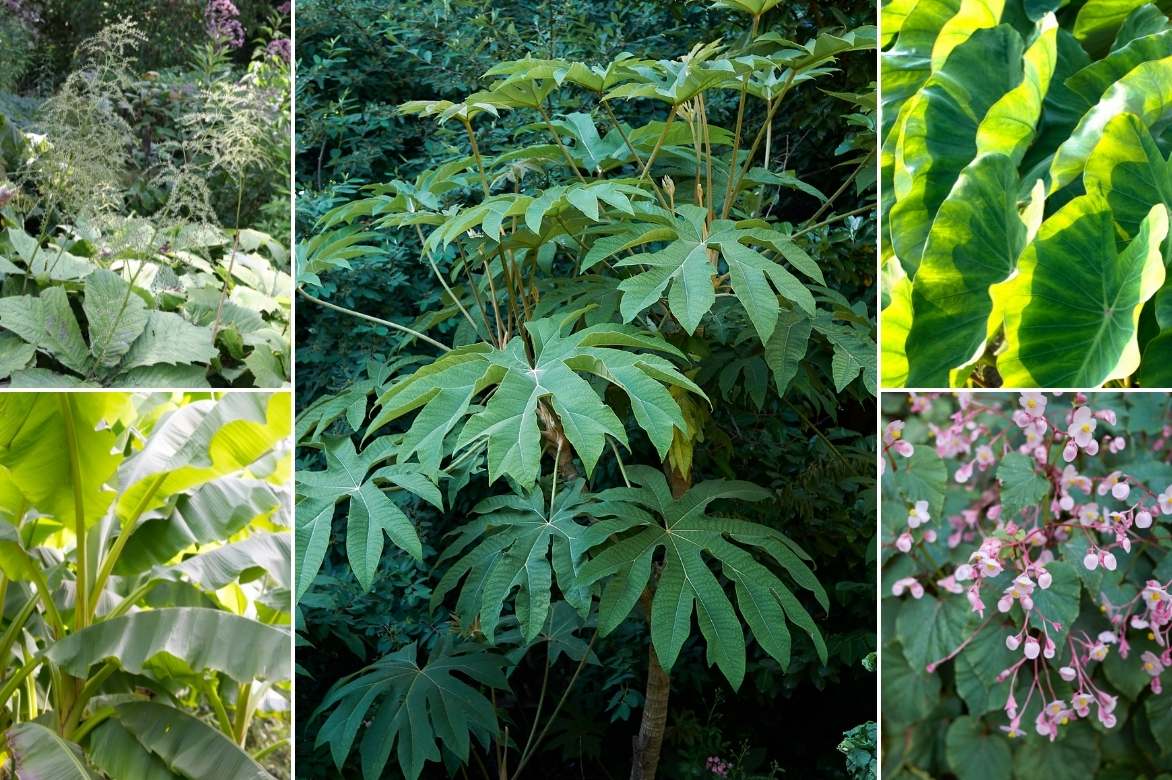
Jungle effect with a Tetrapanax surrounded by Rodgersias podophylla, a banana tree, Colocasias, and Begonias grandis
- When grown in spacious containers suited to its growth, the Tetrapanax also makes a striking addition to patios, terraces, or balconies. Enhance its exotic appeal by pairing it (in separate pots) with boldly structured shade-loving plants whose foliage stands out. Consider the Dryopteris erythrosora, an evergreen fern with finely dissected fronds that emerge coppery-orange in spring. In mild climates (or if overwintered), the purple foliage of an Abyssinian Red Banana enriches the colour palette. Hardy only to -5°C, opt instead for the Japanese Banana, which withstands around -15°C but retains green leaves. Bamboos also excel in pots—even running varieties stay manageable. Prune lower branches to showcase the black canes of Phyllostachys nigra, the golden-yellow stems of ‘Aureocaulis’, or the steely-blue Fargesia ‘Blue Dragon’. For ground cover, try the black-leaved Ophiopogon planiscapus ‘Nigrescens’. For flowering accents, consider the Ornamental Ginger, whose fragrant clusters in warm tones bloom from summer to autumn.
Useful resources
- The Tetrapanax is available in our online nursery.
- Discover 5 ideas for pairing Tetrapanax
- Olivier and Michael present the Tetrapanax in situ in our video.
- Discover our tips for creating an exotic and tropical garden.
- Which plants for an exotic balcony? Check out our selection!
- Subscribe!
- Contents



































Comments